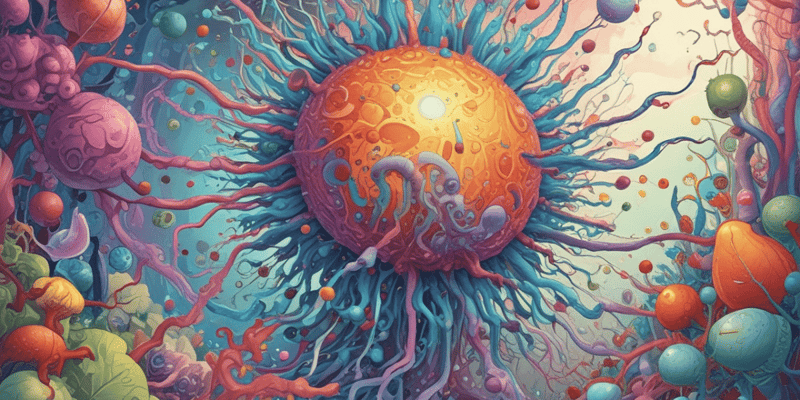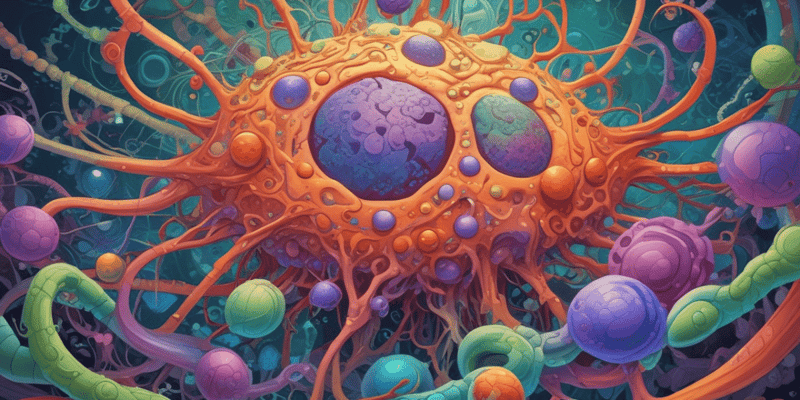Questions and Answers
What is the primary function of natural killer cells in innate immune defense against intracellular viruses?
To recognize and kill virus-infected cells
What is a key difference between the innate and adaptive immune responses?
The innate immune system does not remember prior encounters with microbes
What type of molecules do phagocytes recognize and respond to?
Microbial cell wall components
What is the term used to describe the microbial molecules that stimulate innate immunity?
Signup and view all the answers
What is the function of pattern recognition receptors?
Signup and view all the answers
Why do the components of innate immunity recognize microbial structures?
Signup and view all the answers
What do damage-associated molecular patterns (DAMPs) refer to?
Signup and view all the answers
What is the primary function of type I interferons in innate immune defense against viruses?
Signup and view all the answers
What is the characteristic of naive cells in the immune system?
Signup and view all the answers
What is the result of the activation of memory lymphocytes?
Signup and view all the answers
What is the function of immunologic memory in the immune system?
Signup and view all the answers
What is the difference between the primary and secondary immune responses to antigen X?
Signup and view all the answers
What happens to antibody levels over time after each immunization?
Signup and view all the answers
What is the result of lymphocyte activation by antigens?
Signup and view all the answers
What is the purpose of clonal expansion in the immune system?
Signup and view all the answers
What is a characteristic of immune responses?
Signup and view all the answers
What is a characteristic of healthy cells that prevents them from being attacked by NK cells?
Signup and view all the answers
What is the result of the engagement of inhibitory receptors by healthy cells on NK cells?
Signup and view all the answers
What is the primary function of the Complement System?
Signup and view all the answers
Which pathway of the Complement System is triggered by the presence of antibodies?
Signup and view all the answers
Which component of the immune system is the alternative pathway a part of?
Signup and view all the answers
What is the function of mannose-binding lectin (MBL) in the Complement System?
Signup and view all the answers
Which pathway of the Complement System is initiated by a microbial product in the absence of antibody?
Signup and view all the answers
What is the result of the activation of the Complement System through any of its three pathways?
Signup and view all the answers
Where are the receptors of the innate immune system expressed?
Signup and view all the answers
What is the function of the receptors in the cytosol?
Signup and view all the answers
Which protein family do the receptors for PAMPs and DAMPs belong to?
Signup and view all the answers
What is the outcome of signals generated by engagement of TLRs?
Signup and view all the answers
Which transcription factors are activated by TLR signals?
Signup and view all the answers
What provides physical barriers against infection at the portals of entry of microbes?
Signup and view all the answers
What is the function of epithelia in innate immunity?
Signup and view all the answers
What is the characteristic of the receptors of the innate immune system?
Signup and view all the answers
What happens to naive B cells in peripheral lymphoid tissues during a primary response?
Signup and view all the answers
What is a characteristic of a secondary antibody response?
Signup and view all the answers
What is the role of B cells in antigen presentation to helper T cells?
Signup and view all the answers
What is the result of antigen receptor-mediated B cell activation?
Signup and view all the answers
What is unique about the recognition of antigens by B cells and helper T cells?
Signup and view all the answers
What do B cells express that may play a role in T cell activation?
Signup and view all the answers
What is the role of helper T cells in a secondary antibody response?
Signup and view all the answers
What happens to some plasma cells in a primary response?
Signup and view all the answers
Study Notes
Primary and Secondary Immune Responses
- Naive cells are immunologically inexperienced and have not previously responded to antigens.
- Secondary responses result from the activation of memory lymphocytes, which are long-lived cells induced during the primary immune response.
- Memory lymphocytes remember previous encounters with antigens and respond better upon subsequent encounters.
Antigen-Specific Responses
- Antigens X and Y induce the production of different antibodies, reflecting specificity.
- The secondary response to antigen X is more rapid and larger than the primary response, illustrating memory.
- Antibody levels decline with time after each immunization.
Clonal Expansion and Adaptive Immunity
- When lymphocytes are activated by antigens, they undergo proliferation, generating many thousands of clonal progeny cells with the same antigen specificity.
- Clonal expansion rapidly increases the number of cells specific for the antigen encountered, ensuring adaptive immunity keeps pace with rapidly proliferating microbes.
Innate Immune Defense
- The innate immune system recognizes structures shared by various classes of microbes, not present on normal host cells.
- Innate immunity does not remember prior encounters with microbes and resets to baseline after each encounter.
- Pattern recognition receptors recognize pathogen-associated molecular patterns (PAMPs) and damaged cells (DAMPs).
Components of Innate Immunity
- Phagocytes, natural killer (NK) cells, and cytokines (type I interferons) defend against intracellular viruses.
- Different responses are designed to defend against different classes of microbes.
Cellular Receptors for Microbes and Damaged Cells
- Receptors for PAMPs and DAMPs are expressed on phagocytes, dendritic cells, and other cell types.
- Signals generated by engagement of Toll-like receptors (TLRs) activate transcription factors, stimulating expression of genes involved in antimicrobial functions.
Epithelial Functions in Innate Immunity
- Epithelia provide physical and chemical barriers against infection.
- Continuous epithelia at portals of entry (skin, gastrointestinal, respiratory, and genitourinary tracts) protect against infection.
The Complement System
- The complement system is a collection of circulating and membrane-associated proteins important in defense against microbes.
- Complement activation involves the sequential activation of proteolytic enzymes.
- Three pathways activate the complement system: alternative, classical, and lectin pathways.
Studying That Suits You
Use AI to generate personalized quizzes and flashcards to suit your learning preferences.




